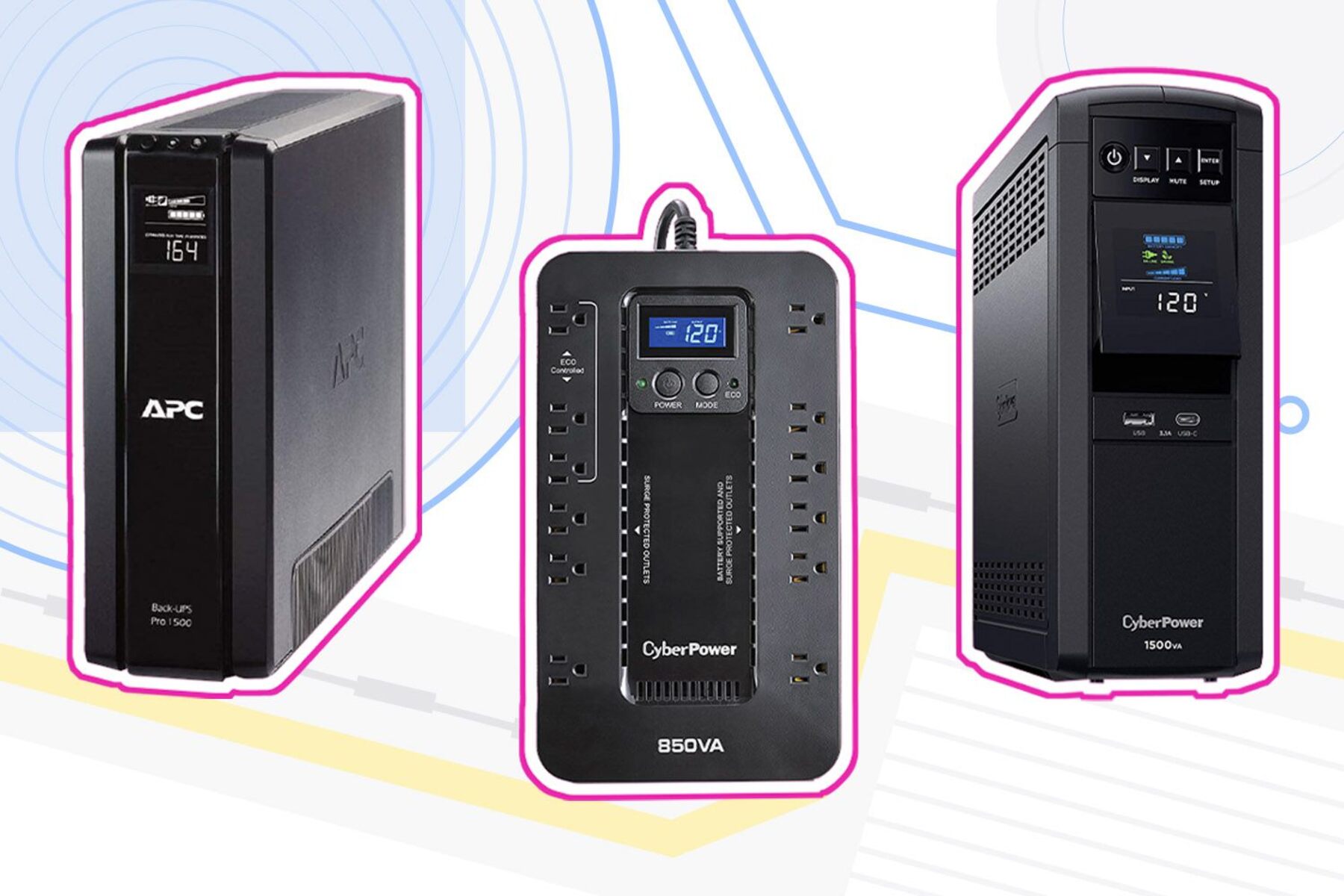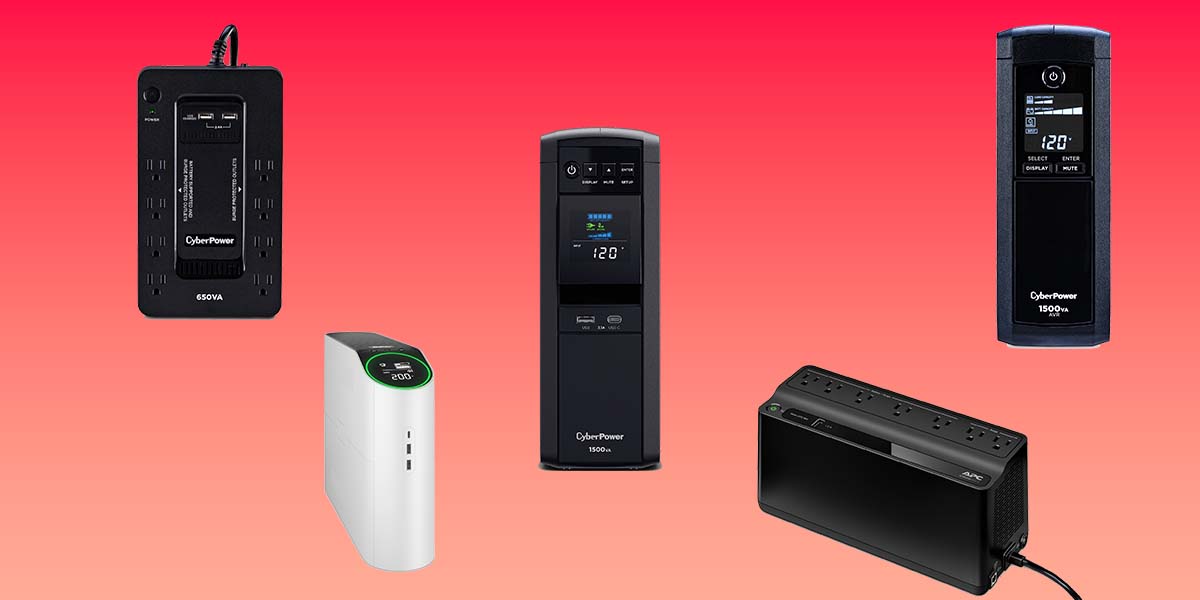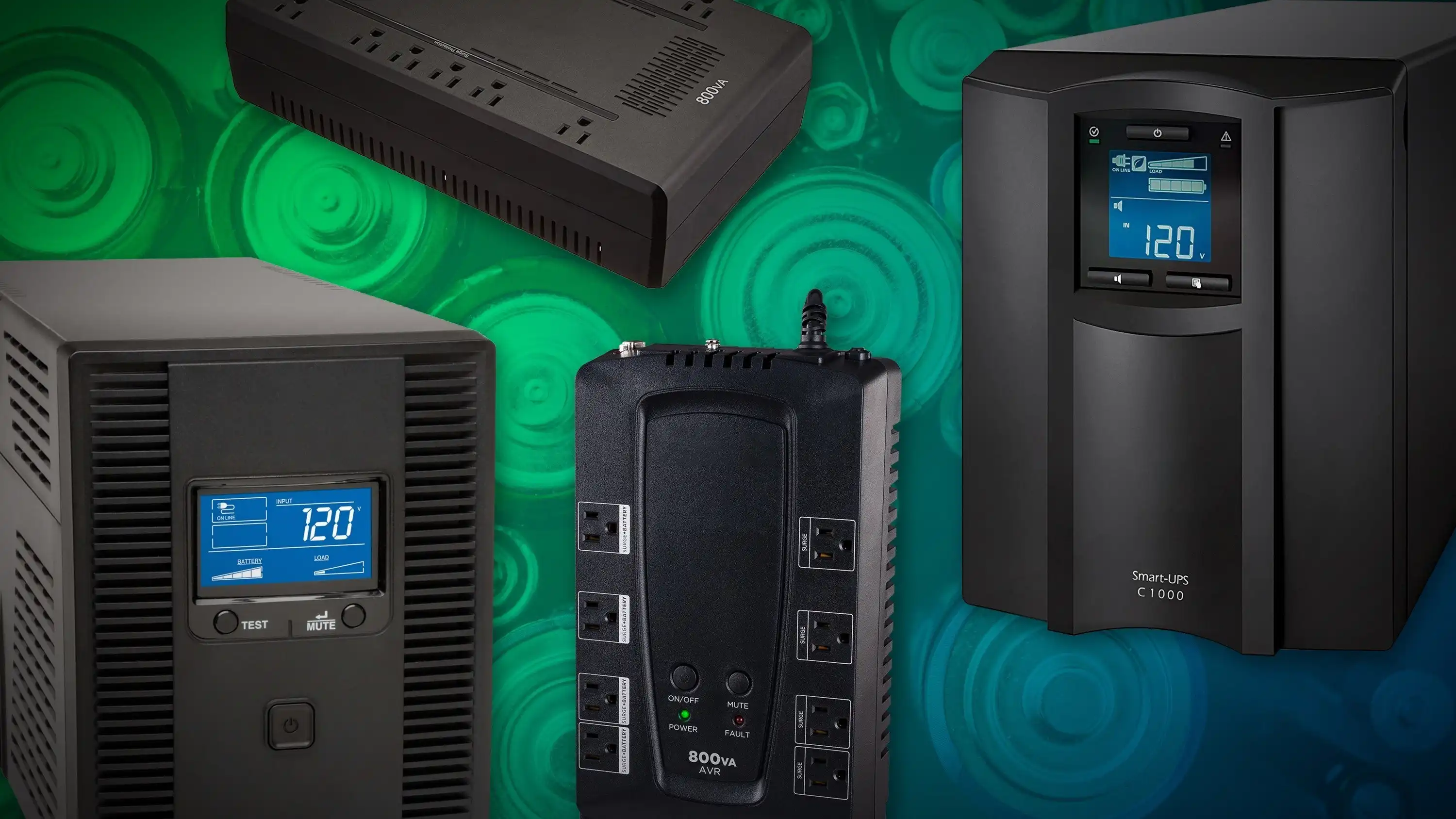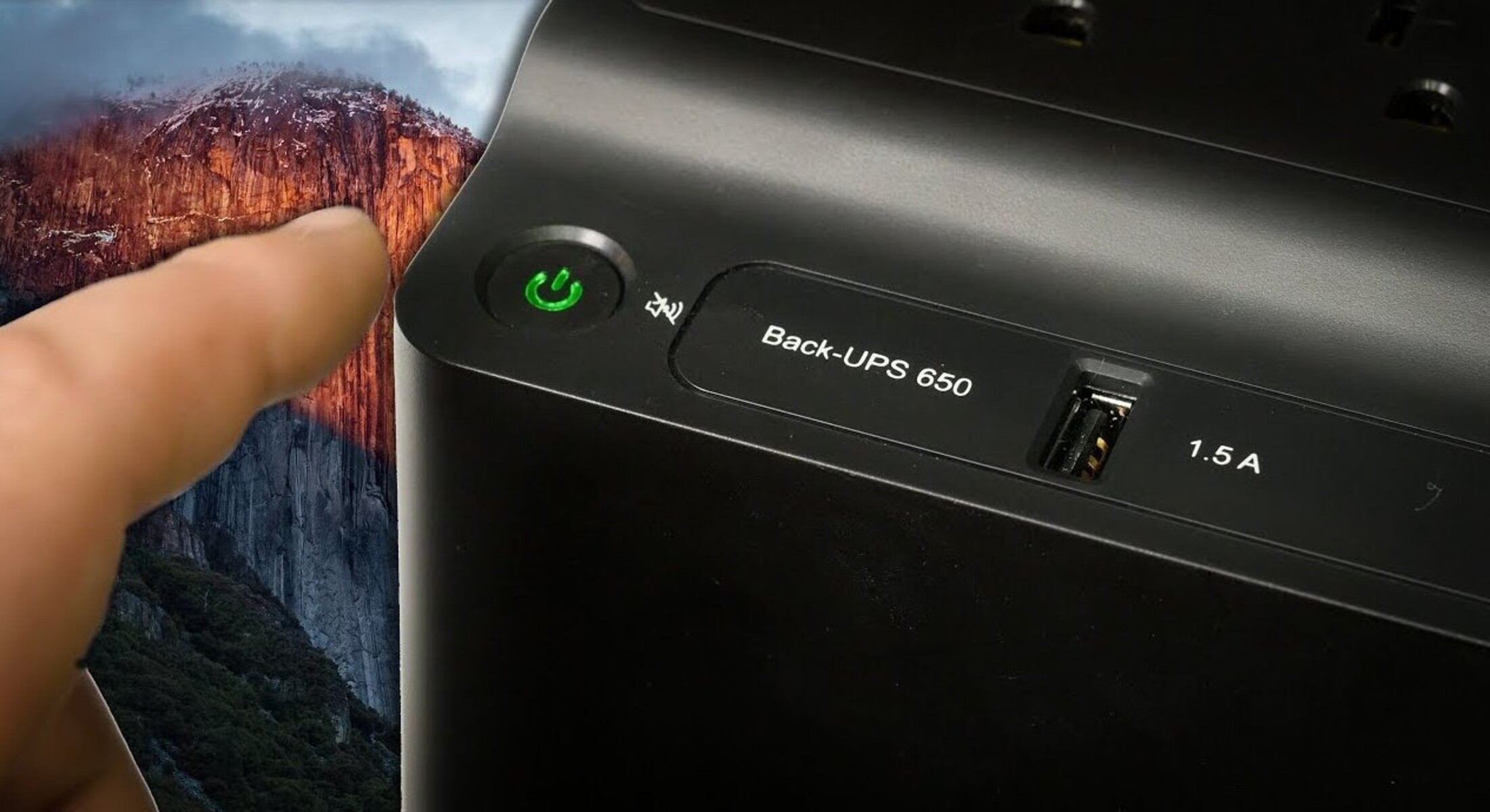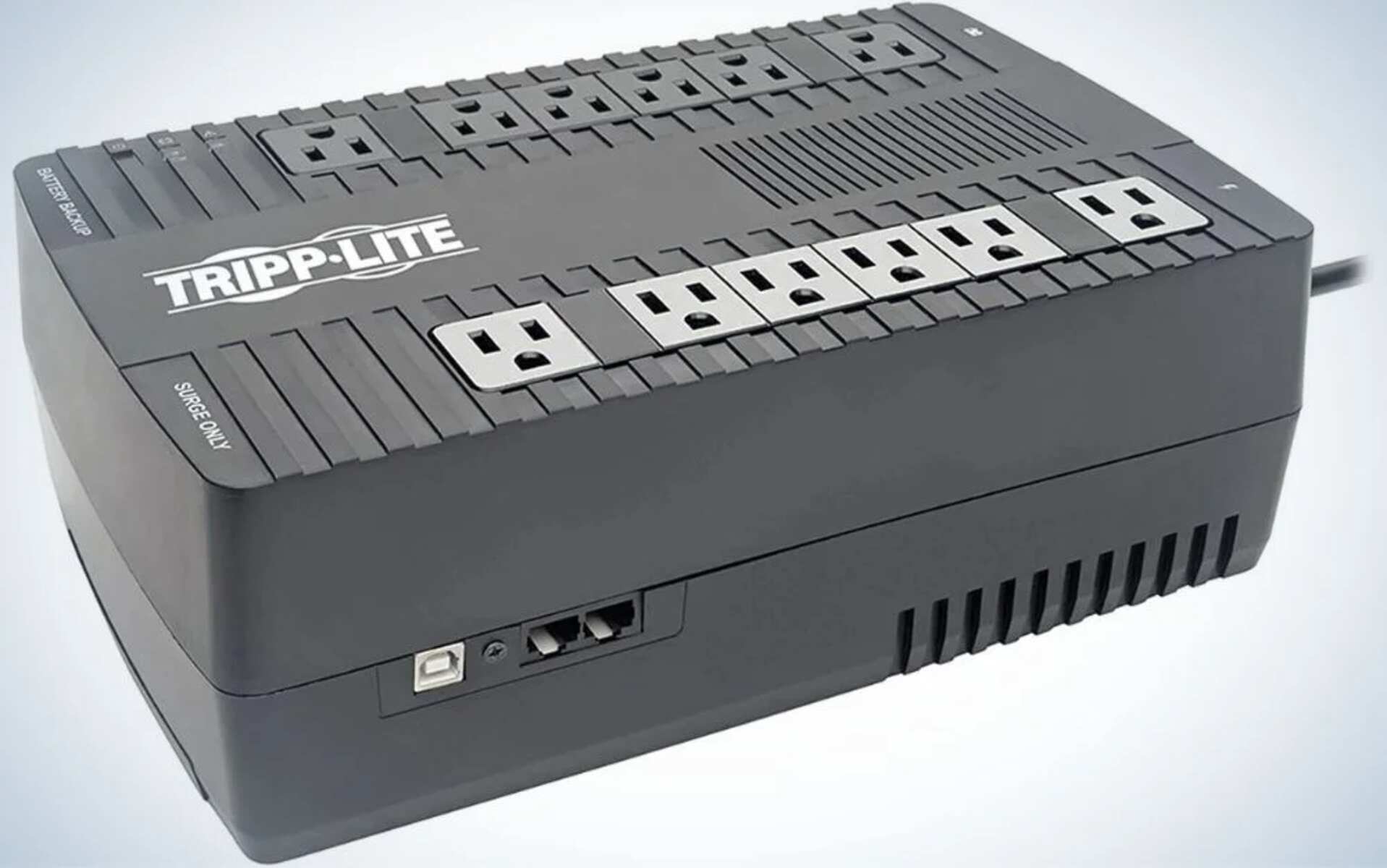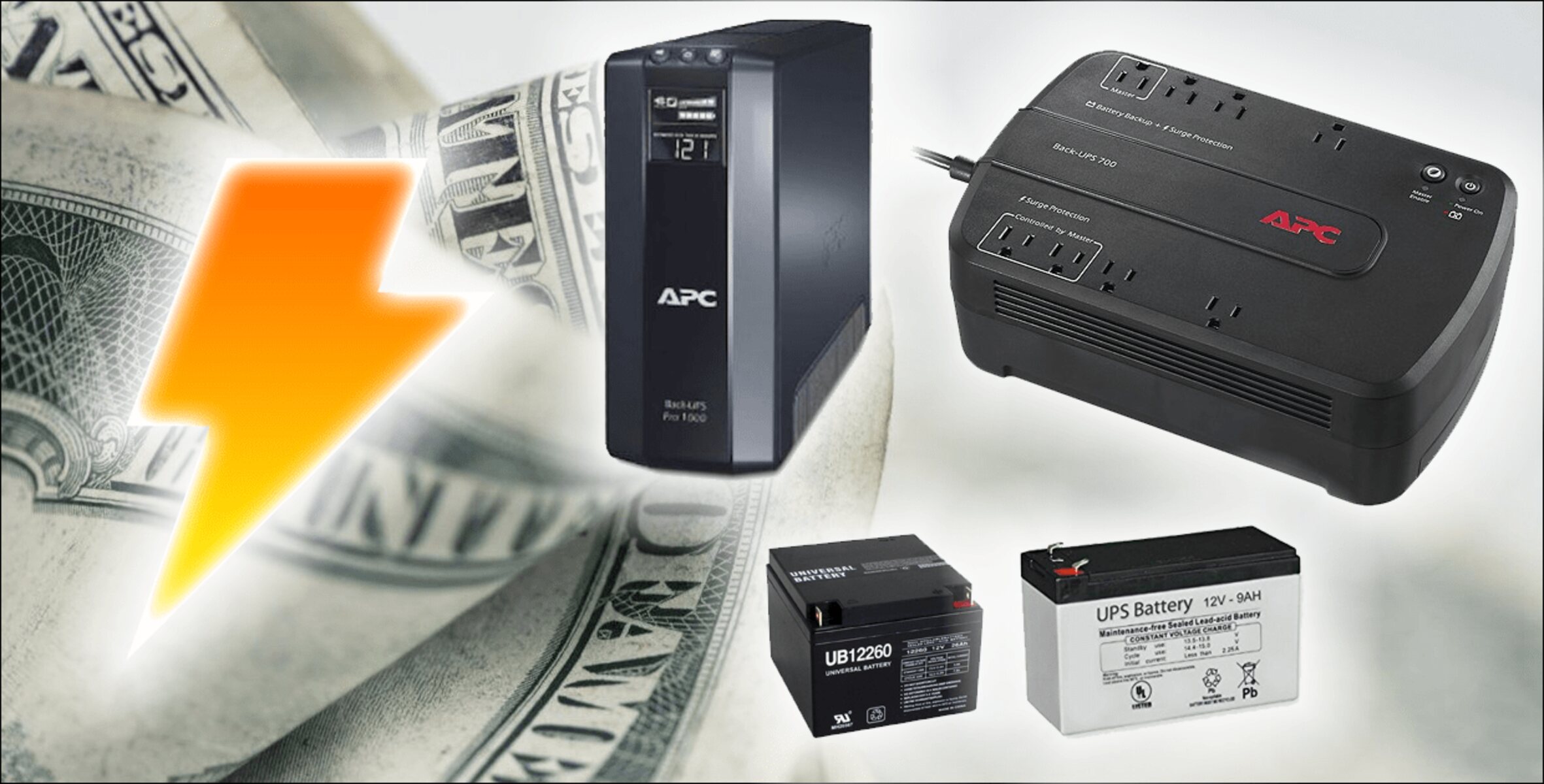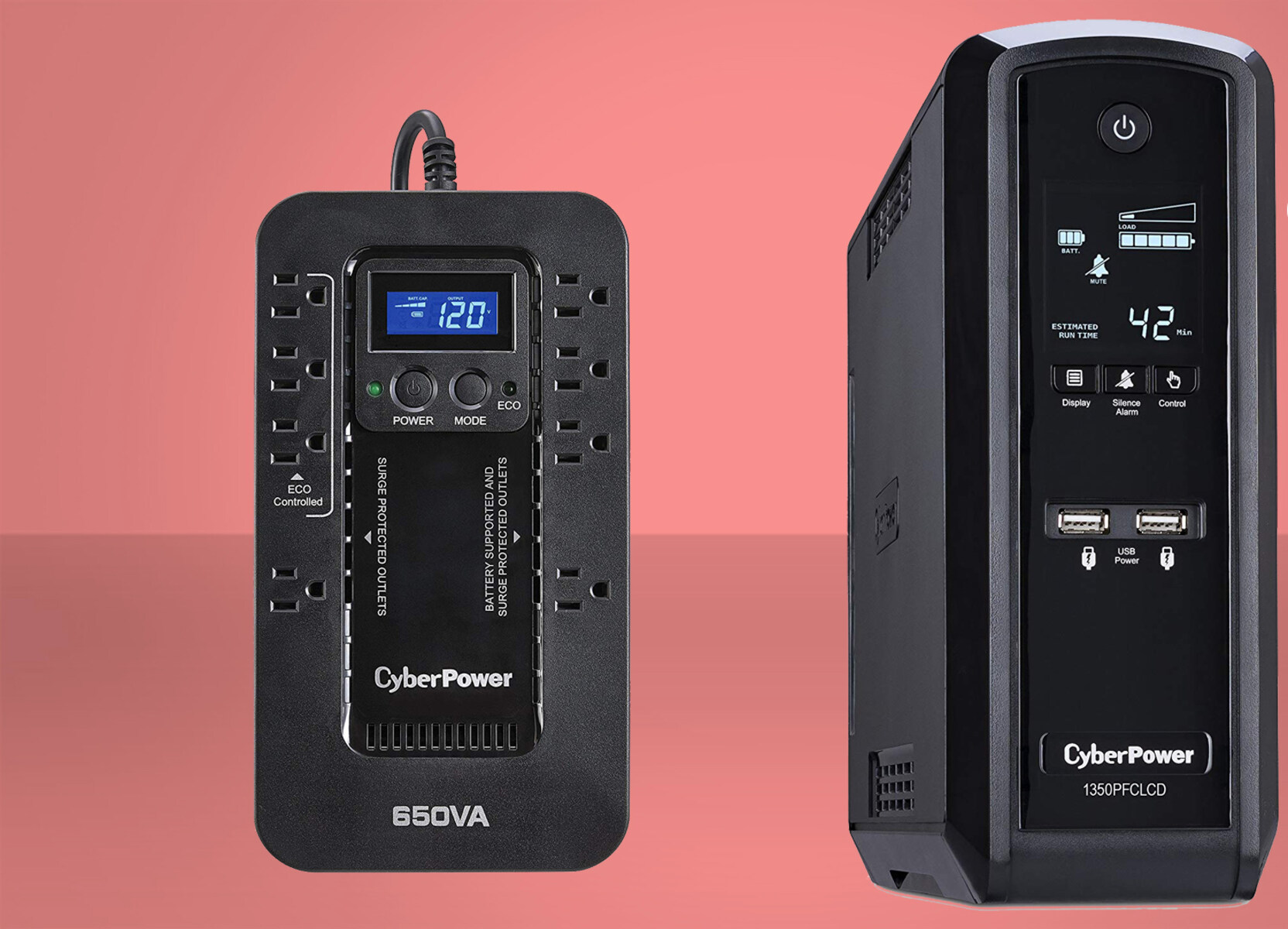Introduction
Welcome to our comprehensive guide on UPS battery backups. Whether you are a home user or a small business owner, having a UPS battery backup is essential for ensuring uninterrupted power supply to your electronic devices. In this article, we will walk you through the basics of UPS battery backups and help you understand what you need to consider before making a purchase decision.
A UPS, or Uninterruptible Power Supply, is a device that provides emergency power to your devices in the event of a power outage or voltage fluctuations. It acts as a bridge between your electronic devices and the main power source, protecting them from sudden power disruptions.
Why do you need a UPS battery backup? Well, we rely heavily on our electronic devices like computers, servers, routers, modems, and other critical equipment. Power outages and voltage fluctuations can cause data loss, system crashes, and even damage the hardware. Having a UPS battery backup is like having an insurance policy for your electronics, providing you with the necessary power backup to safely shut down devices or keep them running during an outage.
In this guide, we will address various factors to consider when choosing a UPS battery backup. We will discuss the capacity, power requirements, backup runtime, types of UPS systems, form factor, input and output connections, UPS management features, surge protection, voltage regulation, and battery maintenance and replacement. By the end of this article, you will have a clear understanding of what you need to look for in a UPS battery backup.
It’s time to take control of your power supply and protect your valuable electronic devices. Let’s dive into the world of UPS battery backups and make an informed decision to ensure a reliable power source for your equipment.
I. Understanding the Basics of UPS Battery Backups
Before diving into the various aspects of selecting a UPS battery backup, it’s important to understand the basic functionality and components of these devices.
A UPS battery backup consists of three main components: the battery, the inverter, and the charger. The battery is the heart of the UPS and stores electrical energy to provide backup power. The inverter converts the DC (direct current) power stored in the battery into AC (alternating current) power that can be used by your devices. The charger recharges the battery when the power is restored.
There are primarily two types of UPS battery backups: online and offline. An online UPS continuously provides power to your devices from its battery, delivering a seamless transition during power outages. An offline UPS, on the other hand, switches to battery power only when the mains power fails. It is important to consider your specific needs and requirements to determine which type of UPS is best suited for your situation.
One crucial aspect of UPS battery backups to consider is the power capacity, which is typically measured in volt-amperes (VA) or in watts (W). The capacity indicates the maximum power load that the UPS can handle. It is essential to calculate the power requirements of your devices and ensure that the UPS capacity can accommodate the total load.
When using a UPS battery backup, it’s important to note that it can provide a limited runtime depending on the load and battery capacity. The runtime refers to the duration for which the UPS can sustain the connected devices during a power outage. It is vital to estimate the backup runtime based on your specific needs, as a longer runtime will require a larger battery capacity.
Additionally, UPS battery backups often come with various features and functionalities that enhance their usability. Some models include LCD displays to provide real-time monitoring of the power status and battery life. Others offer surge protection and voltage regulation to safeguard your devices from power surges and fluctuations. It’s essential to evaluate these features and determine which ones are essential for your requirements.
Now that we have covered the basics of UPS battery backups, let’s move on to the next section, where we will discuss how to select the right UPS capacity for your needs.
II. Selecting the Right UPS Capacity
Choosing the right UPS capacity is crucial to ensure that your devices receive sufficient power backup during an outage. The capacity of a UPS is measured in either volt-amperes (VA) or watts (W). Understanding your power requirements is essential for selecting the appropriate UPS capacity.
To determine the UPS capacity you need, make a list of all the devices you want to connect to the UPS. Include their power ratings, typically listed in watts, on each device’s label or specifications. Add up the power ratings of all the devices to get the total power required.
It’s worth noting that not all devices run at their maximum power rating all the time. Some devices have variable power consumption, and others have standby modes that consume less power. As a general rule, it’s recommended to consider the peak power consumption of each device to account for any power spikes or temporary power demands.
If the power ratings of your devices are given in volt-amperes (VA), you may need to convert them to watts. Most modern electronic devices provide power ratings in watts, but if you are unsure, you can use a simple formula to convert VA to watts. The conversion factor is typically known as the power factor, which is usually mentioned in the device’s specifications. Multiply the VA rating by the power factor to get the power rating in watts.
When selecting a UPS capacity, it’s important to avoid overloading the UPS. Ideally, the power requirements of your devices should be lower than the UPS’s rated capacity. This provides a buffer for any power spikes or future device additions.
Keep in mind that the actual runtime of the UPS is influenced by the load on the system. Higher power requirements result in a shorter backup runtime. Therefore, if you anticipate longer power outages or need extended runtime for critical devices, it’s wise to choose a UPS with a larger capacity.
By accurately assessing your power requirements and selecting a UPS capacity that can handle the total load, you can ensure that your devices are protected and supplied with uninterrupted power during outages. In the next section, we will discuss estimating power requirements for better planning.
III. Estimating Power Requirements
Estimating the power requirements of your devices is essential for selecting an appropriate UPS battery backup. By understanding the power consumption of your devices, you can ensure that the UPS can handle the load and provide sufficient backup power during outages.
To estimate the power requirements, start by identifying all the devices you plan to connect to the UPS. Make a list and note down the power ratings of each device, typically measured in watts. If the power ratings are given in volt-amperes (VA), you can use a power factor to convert them to watts.
The power factor is a measure of how effectively a device converts electrical power into useful work. It varies depending on the type of device. Generally, most electronic devices have a power factor of around 0.7 to 0.9. To calculate the power rating in watts from the VA rating, multiply the VA rating by the power factor.
Once you have the power ratings of all your devices, add them together to get the total power requirements. This will help you determine the minimum UPS capacity you need to handle the load.
It’s important to consider any potential power spikes during operation. Some devices, such as motors or pumps, may require a higher power supply during startup. It’s recommended to account for these spikes by adding a margin of 10-20% to the total power requirements to ensure that the UPS can handle the temporary surge in power demand.
Keep in mind that not all devices need to be connected to the UPS. Non-critical devices or devices that can tolerate short power interruptions can be connected to regular power outlets. Focus on connecting essential devices that require uninterrupted power, such as computers, servers, networking equipment, and sensitive electronics.
When estimating power requirements, be mindful of future expansion. If you plan to add more devices in the future, consider their power consumption as well. It’s always a good idea to have some headroom when selecting a UPS capacity to accommodate any future additions or upgrades.
By accurately estimating your power requirements, accounting for power spikes, and considering future expansion, you can ensure that the UPS battery backup you choose can adequately supply power to your devices and keep them running smoothly during outages. In the next section, we will discuss how to determine the backup runtime you need.
IV. Determining the Backup Runtime
When selecting a UPS battery backup, it’s crucial to consider the backup runtime, which refers to the duration for which the UPS can provide power to your devices during a power outage. The backup runtime is determined by the capacity of the UPS battery and the power load it needs to support.
To determine the backup runtime you need, start by identifying the critical devices that require continuous power during an outage. These are the devices that you want to keep running without interruption. Make a list of their power consumption in watts.
Next, check the specifications of the UPS battery backup you are considering and find its battery capacity, typically measured in volt-ampere-hours (VAh) or ampere-hours (Ah). This indicates the total amount of energy the battery can store.
Divide the battery capacity by the total power consumption of your critical devices to estimate the backup runtime. This will provide you with an approximate duration for which the UPS can sustain the load before the battery is depleted.
It’s important to note that the backup runtime is inversely proportional to the power load. Higher power consumption will result in a shorter runtime, while lower power consumption will enable a longer runtime. Therefore, if you want to increase the backup runtime, you can either reduce the power load connected to the UPS or choose a UPS with a larger battery capacity.
Keep in mind that the backup runtime specified by the manufacturer is typically based on a specific load, often 50% or 75% of the UPS capacity. If your actual power load is significantly different, the runtime may vary. It’s advisable to consult the manufacturer’s documentation or use online runtime calculators provided by UPS manufacturers to get a more accurate estimation.
Additionally, it’s important to consider that the battery capacity may degrade over time. As the battery ages, its ability to hold and deliver power may diminish, leading to a shorter backup runtime. Therefore, it’s recommended to periodically check the battery health and, if necessary, replace it to ensure reliable backup power.
By accurately determining the backup runtime you need and considering factors such as power load and battery capacity, you can select a UPS battery backup that meets your specific requirements and provides sufficient power backup during outages. In the next section, we will explore the different types of UPS systems available.
V. Considering the Types of UPS Systems
When choosing a UPS battery backup, it’s important to consider the different types of UPS systems available. Each type offers unique features and advantages, catering to specific needs and requirements. Understanding the different UPS systems will help you make an informed decision.
1. Offline Standby UPS: This is the most common and affordable type of UPS system. It monitors the incoming power and switches to battery power only when the mains power fails or fluctuates outside acceptable limits. While it provides basic protection against power outages and voltage fluctuations, there may be a brief transfer time between the switchover, which could result in a momentary interruption to your devices.
2. Line Interactive UPS: This UPS system offers additional features compared to the offline standby UPS. It incorporates a voltage regulator that adjusts the voltage to compensate for overvoltage or undervoltage conditions without switching to battery power. This helps protect devices from fluctuations in the mains power and provides a more stable power supply during minor disturbances.
3. Online Double Conversion UPS: Considered the most reliable and efficient UPS system, the online double conversion UPS provides continuous power to your devices by converting the incoming AC power to DC power and then back to AC power. The power is always supplied from the battery, ensuring a seamless transition during power outages without any transfer time. This type of UPS provides the highest level of protection against power issues, including voltage fluctuations, sags, spikes, and surges.
When choosing a UPS system, consider the level of protection you need for your devices and the criticality of your operations. If you require uninterrupted and clean power for sensitive equipment, an online double conversion UPS would be the ideal choice. However, if you have a limited budget and can tolerate brief power interruptions, an offline standby UPS may suffice.
It’s worth noting that more advanced UPS systems may come with additional features such as automatic voltage regulation, advanced monitoring and management capabilities, and the ability to control and shut down devices remotely. These features can enhance the usability and functionality of the UPS system.
By considering the different types of UPS systems and evaluating your specific requirements, you can select a UPS that provides the necessary protection and functionality for your devices. In the next section, we will discuss the form factors of UPS battery backups.
VI. Choosing the Appropriate Form Factor
When selecting a UPS battery backup, it’s important to consider the form factor that best suits your needs. The form factor refers to the physical shape and size of the UPS unit, which can vary depending on the application and space constraints.
There are primarily three common form factors for UPS systems:
1. Tower UPS: Tower UPS units are freestanding and resemble a tower or a desktop computer. They are designed to sit on the floor or a desk and are suitable for small to medium-sized applications. Tower UPS systems provide ease of installation, maintenance, and scalability. They are ideal for home offices, small businesses, and environments where space is not a constraint.
2. Rack-Mount UPS: Rack-mount UPS units are designed to be mounted in server racks or network cabinets, saving valuable floor space. They come in a standardized size that fits perfectly into the rack enclosure. Rack-mount UPS systems are commonly used in data centers, server rooms, and networking setups. They offer high power capacity and allow for easy integration with other rack-mounted equipment.
3. Wall-Mount UPS: Wall-mount UPS units are designed to be mounted on walls, offering flexibility and saving floor space. They are compact in size and typically used in spaces where a floor or rack-mounted UPS is not practical. Wall-mount UPS systems are commonly found in office environments, small server rooms, or locations with limited space.
When choosing the form factor, consider the available space for installation and the specific requirements of your application. If you have a dedicated server rack or network cabinet, a rack-mount UPS would be the best choice to ensure easy integration and efficient use of space. If you have limited floor space or need a UPS for a small office, a tower or wall-mount UPS may be more suitable.
It’s also important to consider future expansion and scalability. If you expect your power requirements to grow in the future, ensure that the chosen UPS form factor can accommodate additional batteries or upgrade options as needed.
Furthermore, consider the accessibility for maintenance and service. Ensure that the chosen form factor allows for easy access to the UPS unit for battery replacement, cleaning, and other routine maintenance tasks.
By selecting the appropriate form factor, you can ensure seamless integration of the UPS unit into your environment while optimizing space and meeting your power backup needs. In the next section, we will discuss the importance of evaluating the input and output connections of a UPS system.
VII. Evaluating the Input and Output Connections
When choosing a UPS battery backup, it’s crucial to evaluate the input and output connections to ensure compatibility and seamless integration with your devices and power sources. Understanding the input and output connections will help you determine how the UPS can be connected to your equipment and how it can provide power during outages.
The input connection of a UPS refers to how it receives power from the main power source. Most UPS units have a standard input connection that can be plugged into a regular power outlet. However, some UPS systems may require a specific type of input connection, such as a twist-lock plug for higher power capacities. It’s important to consider the availability of the appropriate input connection in your environment and ensure compatibility with your power source.
The output connection of a UPS refers to how it delivers power to your devices. UPS units typically feature multiple output outlets or receptacles, allowing you to connect multiple devices. However, it’s essential to consider the type and number of output connections available and determine if they match the requirements of your devices. For example, if your devices require standard electrical plugs, ensure that the UPS provides enough outlets with the appropriate receptacles.
It’s also crucial to consider the type of output waveform generated by the UPS. UPS systems typically produce either a pure sine wave or a modified sine wave. A pure sine wave is an exact replica of the utility power waveform and is suitable for sensitive electronic devices like computers, servers, and medical equipment. A modified sine wave, on the other hand, is a stepped approximation of a sine wave and may not be compatible with certain devices, causing noise or operational issues. It’s important to check the output waveform of the UPS and ensure it is compatible with your devices.
Some UPS units may also offer additional output features such as transfer switches or load shedding capabilities. A transfer switch allows you to switch between UPS power and utility power seamlessly when needed, minimizing any disruption to your devices. Load shedding allows you to prioritize critical devices during power outages, ensuring that essential equipment receives power for a longer duration. Evaluate these features and consider if they align with your specific needs.
By evaluating the input and output connections of a UPS system, you can ensure that it can be seamlessly integrated with your power source and devices. This ensures compatibility and reliable power backup during outages. In the next section, we will explore the importance of assessing the UPS management features.
VIII. Assessing the UPS Management Features
Assessing the management features of a UPS battery backup is essential to optimize its functionality and ensure efficient monitoring and control of the system. UPS management features allow you to monitor the status of the UPS, customize settings, receive notifications, and manage power distribution. Evaluating these features will help you make an informed decision when selecting a UPS for your needs.
1. LCD Display: A UPS with an LCD display provides real-time information about power status, battery health, load capacity, and other important metrics. It allows you to monitor the UPS system at a glance and quickly identify any issues or anomalies.
2. Audible Alarms: Audible alarms provide audio alerts in the event of power outages, low battery, or other critical events. These alarms help ensure that you are aware of any power-related issues even if you are not actively monitoring the UPS display.
3. Remote Monitoring: Some UPS systems offer the ability to remotely monitor and manage the UPS through a network interface. This allows you to access the UPS status and control settings from any location, making it convenient for remote management and troubleshooting.
4. Automatic Voltage Regulation (AVR): AVR is a feature that regulates the voltage supplied by the UPS to keep it within acceptable limits. It helps counteract voltage fluctuations and protects your devices from potential damage caused by high or low voltage levels.
5. Power Management Software: Many UPS units come with power management software that allows you to monitor and manage multiple UPS systems from a centralized interface. This software provides advanced features such as scheduled shutdowns, power usage reports, and automated notifications.
6. Load Management and Shutdown: Advanced UPS systems offer load management capabilities, allowing you to prioritize critical devices during power outages. You can configure the UPS to automatically shut down non-essential devices to extend the backup runtime for critical equipment.
7. Battery Health Monitoring: UPS systems with battery health monitoring features provide insights into the condition of the battery, such as remaining capacity, battery temperature, and estimated battery life. This helps you plan and budget for battery replacements in a timely manner.
When assessing the UPS management features, consider the level of control and monitoring you require for your specific application. Determine the criticality of your devices and whether remote monitoring or load management capabilities are necessary. Additionally, consider if the UPS management software is compatible with your operating system and if it offers the desired functionality for your needs.
By evaluating the management features of a UPS battery backup, you can ensure that it provides the necessary monitoring, control, and protection for your devices. This allows for effective management of power outages and the ability to proactively address any issues that may arise. In the next section, we will discuss the importance of surge protection and voltage regulation in a UPS system.
IX. Checking for Surge Protection and Voltage Regulation
Surge protection and voltage regulation are crucial aspects to consider when selecting a UPS battery backup. These features are designed to safeguard your devices from power surges, spikes, and fluctuations that can cause damage or affect their performance. Checking for surge protection and voltage regulation capabilities is essential for ensuring optimal protection for your equipment.
1. Surge Protection: Power surges are sudden increases in voltage that can occur due to lightning strikes, electrical faults, or switching of electrical devices. These surges can cause irreparable damage to your electronic devices. A UPS with surge protection features helps suppress and divert excess voltage away from your connected devices, preventing potential damage and ensuring their longevity. Look for a UPS that offers surge protection with a high joule rating to provide robust and effective surge suppression.
2. Voltage Regulation: Voltage fluctuations, such as sags (temporary voltage drops) and swells (temporary voltage increases), can adversely impact the performance and lifespan of your devices. A UPS with voltage regulation capabilities helps stabilize the voltage supplied to your devices, ensuring that they receive a constant and steady voltage within acceptable limits. This protects your equipment from potential damage caused by under-voltage or over-voltage conditions.
3. EMI/RFI Filtering: Electrical noise, such as electromagnetic interference (EMI) and radio frequency interference (RFI), can affect the performance of sensitive electronic devices. A UPS with EMI/RFI filtering helps reduce and eliminate this electrical noise, ensuring clean and stable power to your connected equipment. This filtering enhances the reliability and efficiency of your devices, particularly in environments with high levels of electrical interference.
It’s important to assess the surge protection and voltage regulation capabilities of a UPS and determine if they align with the requirements of your devices. Consider the sensitivity of your equipment and the nature of your power supply to determine the level of surge protection and voltage regulation you need.
Additionally, it’s worth noting that surge protection capabilities can diminish over time due to repeated surges or aging of the surge protection components. It’s advisable to periodically check and replace surge protection modules or consider a UPS with modular surge protection for easy replacement.
In summary, checking for surge protection, voltage regulation, and EMI/RFI filtering capabilities in a UPS battery backup is crucial for protecting your devices from power anomalies. These features ensure a stable and reliable power supply, preventing potential damage and ensuring the longevity of your equipment. In the next section, we will discuss battery maintenance and replacement considerations for a UPS system.
X. Reviewing Battery Maintenance and Replacement
Battery maintenance and replacement are important considerations when it comes to UPS systems. The battery is a critical component that provides backup power during outages, and ensuring its optimal performance is essential for the reliable operation of the UPS. Reviewing battery maintenance and replacement guidelines will help you maintain the longevity and functionality of your UPS system.
1. Battery Monitoring: Regularly monitoring the battery status is crucial to ensure its health and performance. Many UPS units come with built-in battery monitoring features that provide information about the battery’s condition, such as remaining capacity, temperature, and charging status. Monitoring the battery allows you to identify any potential issues or degradation and take appropriate actions in a timely manner.
2. Battery Testing: Periodically testing the battery’s capacity is recommended to assess its health and performance. This involves conducting discharge tests to measure the actual capacity of the battery compared to its rated capacity. Battery testing helps identify any degradation or capacity loss, indicating the need for battery replacement or maintenance.
3. Battery Replacement: Over time, batteries lose their capacity to hold and deliver power. It’s important to follow the manufacturer’s recommended battery replacement schedule or closely monitor the battery’s performance to determine when it needs to be replaced. Regularly replacing the battery ensures that the UPS can provide the necessary backup power during outages and maintains the overall reliability of the system.
4. Battery Maintenance: Proper maintenance of the battery is essential for its longevity and optimal performance. This includes keeping the battery clean and free of dust or debris, ensuring proper ventilation and temperature control, and regularly checking the battery terminals for corrosion or loose connections. Additionally, avoid exposing the battery to extreme temperatures or direct sunlight, as it can impact its performance and lifespan.
5. Battery Disposal: When replacing the battery, it’s important to follow proper disposal procedures as batteries contain hazardous materials. Check your local regulations or consult with a certified battery recycling facility for appropriate disposal methods to ensure the safe and environmentally-friendly handling of the old battery.
By reviewing the battery maintenance and replacement guidelines provided by the UPS manufacturer, you can ensure that the battery remains in optimal condition for reliable backup power. Regular battery monitoring, testing, and replacement are integral to the longevity and functionality of the UPS system.
Remember to always consult the manufacturer’s documentation or seek professional assistance when performing any battery maintenance or replacement tasks.
Now that we have discussed battery maintenance and replacement, let’s conclude our comprehensive guide on UPS battery backups and how to select the right one for your needs.
Conclusion
In conclusion, selecting the right UPS battery backup is crucial for ensuring uninterrupted power supply and protecting your valuable electronic devices. By understanding the basics of UPS systems, such as the different types, capacity calculations, and backup runtime estimations, you can make an informed decision.
Considering the form factor of the UPS will help you choose the most suitable design for your space, whether it be a tower, rack-mount, or wall-mount unit. Evaluating the input and output connections ensures compatibility with your devices and power sources, while assessing the management features allows for efficient monitoring and control of the UPS.
Surge protection and voltage regulation features safeguard your equipment from power anomalies, and regular battery maintenance and timely replacement ensure reliable backup power. It’s important to monitor the battery’s condition and test its capacity periodically to ensure optimal performance.
By following these guidelines and understanding your specific power requirements, you can select the right UPS battery backup that provides seamless power backup during outages and protects your devices from potential damage.
Remember to consult the manufacturer’s documentation, seek professional assistance if needed, and comply with proper battery disposal procedures to ensure the safe and efficient operation of your UPS system.
Investing in a UPS battery backup is investing in the protection of your electronic devices and the continuity of your operations. By taking the time to assess your needs and consider the various factors discussed in this guide, you can make a well-informed decision and have peace of mind knowing that your devices are backed up with reliable power supply. Choose wisely and stay powered up!







